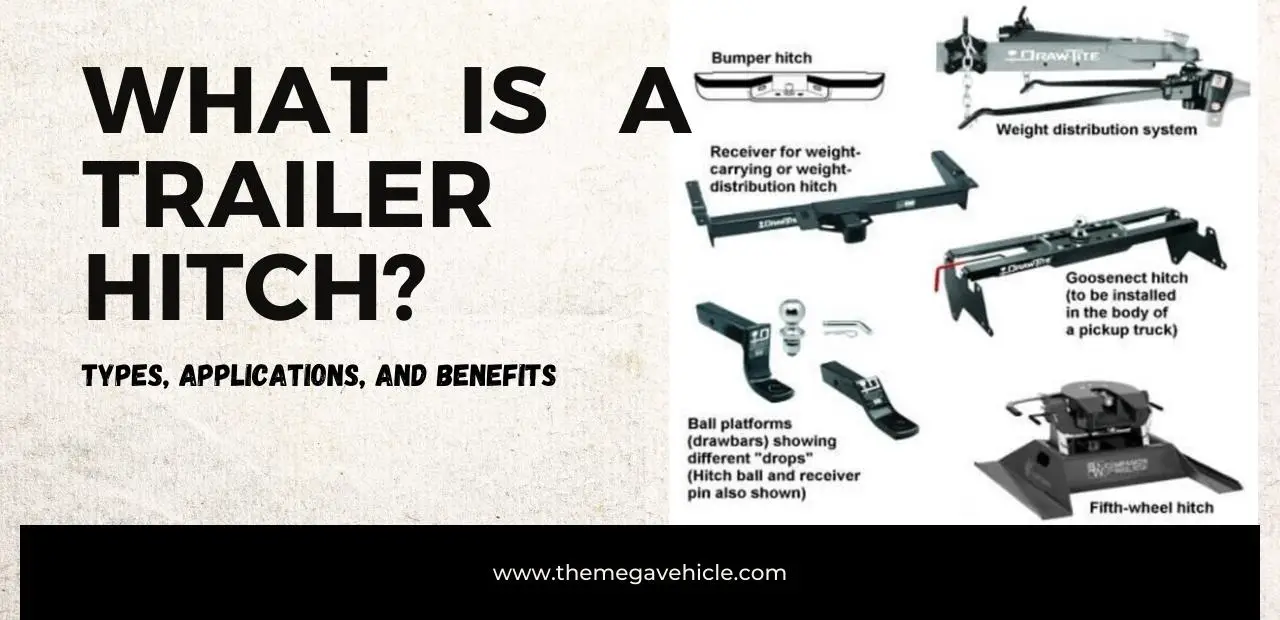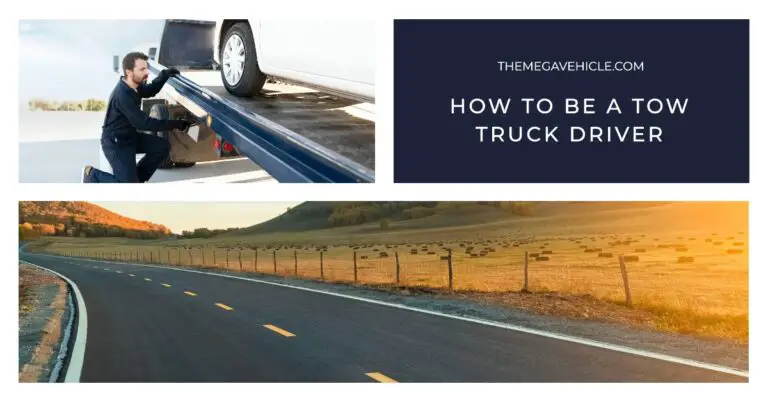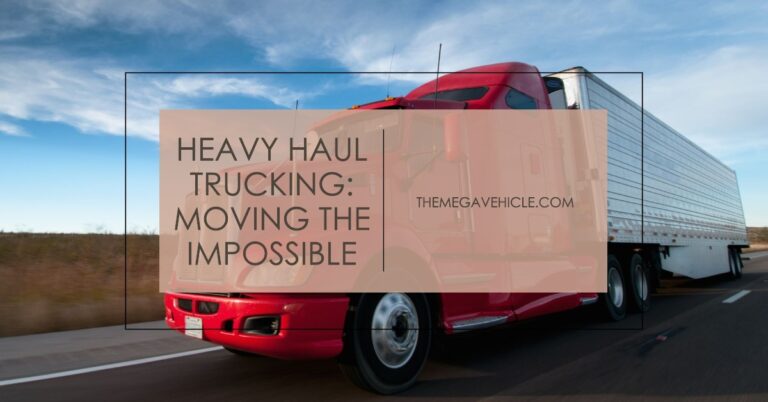What is a Trailer Hitch? Types, Applications, and Benefits

What is a trailer hitch?
A trailer hitch is a device attached to the rear of a vehicle that allows it to tow or carry trailers, campers, or other types of equipment. It provides a secure connection between the vehicle and the trailer, enabling safe transportation of heavy loads. Trailer hitches come in various types and sizes, depending on the weight capacity and towing needs of the vehicle.
How Trailer Hitches are Used in Different Industries
Trailer hitches are versatile devices that allow vehicles to tow trailers for a variety of purposes. They are essential tools in many industries, including construction, agriculture, transportation, landscaping, forestry, oil and gas, mining, and emergency services.
Construction
Trailer hitches enable construction companies to transport heavy equipment and materials to job sites efficiently and cost-effectively. Examples of equipment that can be towed with trailer hitches include bulldozers, excavators, concrete mixers, and dump trucks.
Agriculture
Trailer hitches are also widely used in the agriculture industry. Farmers use them to transport agricultural machinery and supplies, such as tractors, harvesters, and plows. Trailer hitches also allow farmers to transport their crops to market.
Transportation
Trailer hitches are also essential for the transportation industry. They allow trucks and other vehicles to tow trailers carrying goods and cargo across long distances. This helps to keep the supply chain moving and ensures that goods are delivered to consumers on time.
Other Applications
Trailer hitches are also used in a variety of other industries and sectors, including:
- Landscaping: Trailer hitches are used to transport landscaping equipment and materials, such as lawnmowers, trimmers, and edgers.
- Forestry: Trailer hitches are used to transport forestry equipment and materials, such as logs and timber.
- Oil and gas: Trailer hitches are used to transport oil and gas equipment and supplies, such as drilling rigs and pipelines.
- Mining: Trailer hitches are used to transport mining equipment and supplies, such as excavators and dump trucks.
- Emergency services: Trailer hitches are used to tow emergency vehicles and equipment, such as ambulances and fire trucks.
Benefits of Trailer Hitches
Trailer hitches offer a number of benefits, including:
- Increased efficiency: Trailer hitches allow businesses to transport more goods and materials more efficiently. This can lead to significant cost savings.
- Improved safety: Trailer hitches provide a secure connection between the towing vehicle and the trailer, which helps to prevent accidents.
- Increased versatility: Trailer hitches can be used to tow a variety of different types of trailers, which gives businesses more flexibility.
- Increased resale value: Vehicles with trailer hitches tend to have a higher resale value.
Trailer Hitch Types
1. Receiver Hitch
A receiver hitch is a type of trailer hitch that consists of a square or round receiver tube that is attached to the frame of a vehicle. The receiver tube allows for a variety of towing accessories to be attached, such as a ball mount, tow hook, or bike rack.
Receiver hitches are the most common type of trailer hitch, and they are available in a variety of weight capacities to accommodate different types of trailers. Receiver hitches are also relatively easy to install, making them a popular choice for DIYers.
Common Applications of Receiver Hitch
Receiver hitches can be used for a variety of purposes, including:
- Towing trailers: Receiver hitches are most commonly used to tow trailers, such as boat trailers, camper trailers, and utility trailers.
- Carrying accessories: Receiver hitches can also be used to carry accessories, such as bike racks, cargo carriers, and snowplows.
- Recovering disabled vehicles: Receiver hitches can also be used to recover disabled vehicles.
2. Gooseneck Hitch
A gooseneck hitch is a type of trailer hitch that consists of a ball mount that is attached to the bed of a pickup truck. The ball mount is connected to a coupler on the trailer, which allows the trailer to pivot and move independently of the truck.
Gooseneck hitches are designed to tow heavy-duty trailers, such as livestock trailers, horse trailers, and construction equipment trailers. They provide a more stable and secure connection between the towing vehicle and the trailer than other types of hitches, such as receiver hitches.
Common Applications of Gooseneck Hitch
Gooseneck hitches are commonly used in the following industries:
- Agriculture: Farmers use gooseneck hitches to tow livestock trailers, horse trailers, and agricultural equipment trailers.
- Construction: Construction companies use gooseneck hitches to tow construction equipment trailers, such as dump trucks and excavators.
- Oil and gas: Oil and gas companies use gooseneck hitches to tow trailers carrying oilfield equipment and supplies.
- Mining: Mining companies use gooseneck hitches to tow trailers carrying mining equipment and supplies.
- Transportation: Transportation companies use gooseneck hitches to tow heavy-duty trailers, such as flatbed trailers and refrigerated trailers.
3. Fifth Wheel Hitch
A fifth wheel hitch is a type of trailer hitch that is designed to tow heavy-duty trailers, such as fifth wheel RVs and livestock trailers. It consists of a large, flat plate that is mounted in the bed of a pickup truck. The plate has a horseshoe-shaped opening that the kingpin on the trailer fits into.
Fifth wheel hitches are more stable and secure than other types of hitches, such as receiver hitches and gooseneck hitches. This is because the weight of the trailer is evenly distributed over the bed of the truck. Fifth wheel hitches also allow for more articulation between the truck and the trailer, which makes it easier to maneuver the trailer in tight spaces.
Common Applications of Fifth Wheel Hitch
Fifth wheel hitches are commonly used in the following applications:
- Recreational vehicles: Fifth wheel RVs are a popular type of RV because they are spacious and comfortable. Fifth wheel hitches are required to tow fifth wheel RVs.
- Livestock trailers: Fifth wheel hitches are also commonly used to tow livestock trailers, such as horse trailers and cattle trailers.
- Construction equipment trailers: Fifth wheel hitches can also be used to tow construction equipment trailers, such as dump trucks and excavators.
- Other heavy-duty trailers: Fifth wheel hitches can also be used to tow other types of heavy-duty trailers, such as flatbed trailers and refrigerated trailers.
4. Pintle Hitches
A pintle hitch is a type of trailer hitch that consists of a large, hook-shaped pin (the pintle) that is attached to the rear of a vehicle. The pintle fits into a ring or coupler on the trailer, which allows the trailer to be towed.
Pintle hitches are designed to tow very heavy-duty trailers, such as agricultural equipment trailers and construction equipment trailers. They are also commonly used to tow military equipment trailers. Pintle hitches are very strong and durable, but they can be difficult to connect and disconnect.
Common Applications of Pintle Hitches
Pintle hitches are commonly used in the following applications:
- Agriculture: Farmers use pintle hitches to tow agricultural equipment trailers, such as grain trailers, livestock trailers, and fertilizer trailers.
- Construction: Construction companies use pintle hitches to tow construction equipment trailers, such as dump trucks, excavators, and bulldozers.
- Military: The military uses pintle hitches to tow military equipment trailers, such as tanks, artillery pieces, and troop carriers.
- Other heavy-duty applications: Pintle hitches can also be used to tow other types of heavy-duty trailers, such as logging trailers and flatbed trailers.
5. Weight Distribution Hitches
A weight distribution hitch (WDH) is a type of trailer hitch that helps to distribute the weight of a trailer more evenly between the towing vehicle and the trailer. This improves handling and safety, especially when towing a heavy trailer or when driving in windy or icy conditions.
WDHs work by using a system of levers and spring bars to transfer weight from the rear axle of the towing vehicle to the front axle of the towing vehicle and the axles of the trailer. This helps to level out the towing vehicle and trailer, making them easier to control.
Common Applications of Weight Distribution Hitches
WDHs are commonly used in the following applications:
- Towing heavy trailers: WDHs are ideal for towing heavy trailers, such as fifth wheel RVs, livestock trailers, and construction equipment trailers.
- Towing trailers in windy or icy conditions: WDHs can help to improve handling and safety when towing a trailer in windy or icy conditions.
- Towing trailers with a lightweight towing vehicle: WDHs can help to improve handling and safety when towing a trailer with a lightweight towing vehicle, such as a crossover SUV or minivan.
6. Front-Mount Hitches
Front-mount hitches are trailer hitches that are attached to the front of a vehicle. They are less common than rear-mount hitches, but they offer a number of advantages.
Front-mount hitches allow you to tow a trailer with your vehicle’s front wheels, which can improve steering and control. They can also be used to mount winches, snow plows, and other accessories.
Common Applications of Front-Mount Hitches
Front-mount hitches are commonly used in the following applications:
- Towing trailers in tight spaces: Front-mount hitches can be helpful for towing trailers in tight spaces, such as when parking at a campsite or maneuvering through a narrow alley.
- Towing heavy trailers: Front-mount hitches can also be helpful for towing heavy trailers, as they can help to distribute the weight more evenly between the front and rear axles of the vehicle.
- Towing trailers in windy conditions: Front-mount hitches can also improve stability when towing a trailer in windy conditions.
- Mounting accessories: Front-mount hitches can be used to mount a variety of accessories, such as winches, snow plows, and cargo carriers.
Different Classes of Trailer Hitches
Whether you’re an avid adventurer hauling a boat for a weekend getaway or a construction worker transporting heavy equipment, trailer hitches are the unsung heroes that connect your vehicle to your towing needs. These versatile devices, discreetly mounted at the rear of vehicles, come in various classes, each designed to handle specific weight capacities. Understanding these classes is crucial for selecting the right hitch for your towing requirements and ensuring a safe and successful journey.
Navigating the Hitch Class Spectrum
Trailer hitches are categorized into five classes, each denoted by a Roman numeral:
- Class I: These lightweight hitches, with a weight capacity of up to 2,000 pounds, are ideal for towing small trailers like bike racks, compact cargo trailers, or lightweight utility trailers.
- Class II: A step up from Class I, these hitches boast a weight capacity of up to 3,500 pounds, making them suitable for towing small boats, personal watercraft, and pop-up campers.
- Class III: The most common type of hitch, Class III hitches can handle weights up to 5,000 pounds, making them versatile for towing a wide range of trailers, including medium-sized boats, campers, and horse trailers.
- Class IV: Designed for heavier-duty towing, Class IV hitches can handle weights up to 10,000 pounds, making them suitable for larger trailers like full-sized campers, livestock trailers, and construction equipment.
- Class V: The pinnacle of towing strength, Class V hitches can handle weights up to 20,000 pounds, making them ideal for towing massive trailers like flatbed trailers, heavy-duty construction equipment, and even large RVs.
Here is a table summarizing the five classes of trailer hitches:
| Hitch Class | Weight Capacity | Typical Uses |
|---|---|---|
| Class I | Up to 2,000 pounds | Light trailers such as small jet skis, motorcycles, or bike racks |
| Class II | Up to 3,500 pounds | Small boats, campers, and utility trailers |
| Class III | Up to 5,000 pounds | Medium-sized boats, campers, and horse trailers |
| Class IV | Up to 10,000 pounds | Large trailers such as full-sized campers, horse trailers, and construction equipment |
| Class V | Up to 20,000 pounds | Very large trailers such as flatbed trailers and heavy-duty construction equipment |
Trailer hitch installation is an important task that should be done carefully to ensure the safety of the vehicle and the trailer. By following the manufacturer’s instructions, using the correct tools and equipment, and having the hitch inspected by a professional, you can help to prevent accidents and injuries.






